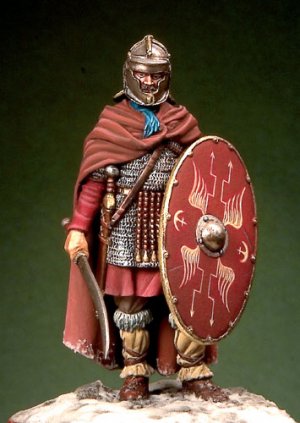

Ref.: ROME-54038

Roman auxiliary soldier - End of II Century A.C. Auxiliary units were an essential component of roman army, which importance increased since the time of the "marian reform" of around 100 b.C.: roman citizens enlisted in the legions were all equipped as heavy infantry Since that moment more than in the past became necessary flank legionary infantry with units of different type like cavalry, light infantry, skirmishers and bowmen basic on all battlefields and more in particular tactical situations not suitable for heavy infantry. Auxiliary units, organized in numeri infantry cohortes, cavalry alae or mixed cohortes equitatae (all quingenariae or milliariae), were raised from soldiers coming from all the imperial provinciae attracted by the opportunity to become roman citizens after twenty five years of service. By the 212 a.C., when emperor Caracalla's Constitutio Antoniniana gave roman citizenship to all the people in the empire, became more difficult distinguish between the legions (in which were enlisted more and more "barbarians") and the auxiliary units, permanently employed to guard the frontiers. Our soldier wears an heavy iron helmet with bronze trimmings, reproduced from an original one discovered near Heddernheim (D), now exposed in the Frankfurt Museum; this helmet, classified by Russell Robinson as "auxiliary cavalry helmet type E”, was probably used by the infantry too and, judging by the findings, its employment, in many variants, was very wide; the oval shield with bronze rim was typical of the auxiliary infantry and cavalry but, by the III century, its use increased amongst the legions; the iron rings mail cuirass was used by auxiliaries and legionaries through all the empire; the diameter of the roman rings varied between 3 and 9 millimeters; the belt shows plates and leather pendants with studs trimmed in iron, silver or bronze; the “gladius” has wooden pommel and guard bone handle; the scabbard is made in wood with bronze trimmings: in this age it will be soon replaced with the longer “spatha”; the soldier wears typical roman military mantle, called "paenula" with buttons in front and cape at the back, indifferently used by legionaries and auxiliaries; mantle and trousers would be painted in dark colors. like brown or gray; heavy winter shoes were in leather; many roman shoes, both military or not, were discovered in the bottom. of wells excavated inside roman forts, used as dumps when dried. The "falx" captured to the enemy is in iron with wooden handle.